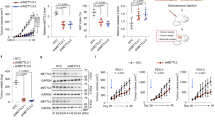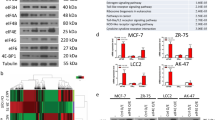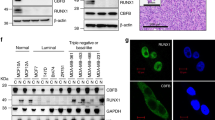Abstract
Methyltransferase-like 3 (METTL3) is the catalytic subunit of the N6-adenosine methyltransferase complex responsible for N6-methyladenosine (m6A) modification of mRNA in mammalian cells. Although METTL3 expression is increased in several cancers, the regulatory mechanisms are unclear. We explored the regulatory roles of peptidyl-prolyl cis-trans isomerase NIMA-interacting 1 (PIN1) in METTL3 stability and m6A modification of mRNA. PIN1 interacted with METTL3 and prevented its ubiquitin-dependent proteasomal and lysosomal degradation. It stabilized METTL3, which increased the m6A modification of transcriptional coactivator with PDZ-binding motif (TAZ) and epidermal growth factor receptor (EGFR) mRNA, resulting in their efficient translation. PIN1 knockout altered the distribution of TAZ and EGFR mRNA from polysomes into monosomes. Inhibition of MEK1/2 kinases and PIN1 destabilized METTL3, which impeded breast cancer cell proliferation and induced cell cycle arrest at the G0/G1 phases. METTL3 knockout reduced PIN1 overexpression-induced colony formation in MCF7 cells and enhanced tumor growth in 4T1 cells in an orthotopic mouse model. In clinical settings, METTL3 expression significantly increased with tumor progression and was positively correlated with PIN1 expression in breast cancer tissues. Thus, PIN1 plays a regulatory role in mRNA translation, and the PIN1/METTL3 axis may be an alternative therapeutic target in breast cancer.
This is a preview of subscription content, access via your institution
Access options
Subscribe to this journal
Receive 50 print issues and online access
$259.00 per year
only $5.18 per issue
Buy this article
- Purchase on Springer Link
- Instant access to full article PDF
Prices may be subject to local taxes which are calculated during checkout







Similar content being viewed by others

Data availability
The proteomic analysis results published here are wholly- or partly based upon the data generated through The Cancer Dependency Map (DepMap) Project at the Broad Institute (The Cancer Target Discovery and Development screening project) and TCGA. The authors confirm that the data supporting the findings of this study are available within the article and its supplementary materials.
References
Chen Y, Wu Y-R, Yang H-Y, Li X-Z, Jie M-M, Hu C-J, et al. Prolyl isomerase Pin1: a promoter of cancer and a target for therapy. Cell Death Dis. 2018;9:883.
Rustighi A, Zannini A, Campaner E, Ciani Y, Piazza S, Del Sal G. PIN1 in breast development and cancer: a clinical perspective. Cell Death Differ. 2017;24:200–11.
Lu KP, Finn G, Lee TH, Nicholson LK. Prolyl cis-trans isomerization as a molecular timer. Nat Chem Biol. 2007;3:619–29.
Thapar R. Roles of prolyl isomerases in RNA-mediated gene expression. Biomolecules. 2015;5:974–99.
Keene JD. Ribonucleoprotein infrastructure regulating the flow of genetic information between the genome and the proteome. Proc Natl Acad Sci. 2001;98:7018–24.
Khanal P, Kim G, Lim SC, Yun HJ, Lee KY, Choi HK, et al. Prolyl isomerase Pin1 negatively regulates the stability of SUV39H1 to promote tumorigenesis in breast cancer. FASEB J. 2013;27:4606–18.
Farrell AS, Pelz C, Wang X, Daniel CJ, Wang Z, Su Y, et al. Pin1 regulates the dynamics of c-Myc DNA binding to facilitate target gene regulation and oncogenesis. Mol Cell Biol. 2013;33:2930–49.
Fujiyama-Nakamura S, Yoshikawa H, Homma K, Hayano T, Tsujimura-Takahashi T, Izumikawa K, et al. Parvulin (Par14), a peptidyl-prolyl cis-trans isomerase, is a novel rRNA processing factor that evolved in the metazoan lineage. Mol Cell Proteom. 2009;8:1552–65.
Shen ZJ, Malter JS. Regulation of AU-rich element RNA binding proteins by phosphorylation and the prolyl isomerase Pin1. Biomolecules. 2015;5:412–34.
Nechama M, Uchida T, Mor Yosef-Levi I, Silver J, Naveh-Many T. The peptidyl-prolyl isomerase Pin1 determines parathyroid hormone mRNA levels and stability in rat models of secondary hyperparathyroidism. J Clin Invest. 2009;119:3102–14.
Choi J, Chen J, Schreiber SL, Clardy J. Structure of the FKBP12-rapamycin complex interacting with the binding domain of human FRAP. Science. 1996;273:239–42.
Lee NY, Choi H-K, Shim J-H, Kang K-W, Dong Z, Choi HS. The prolyl isomerase Pin1 interacts with a ribosomal protein S6 kinase to enhance insulin-induced AP-1 activity and cellular transformation. Carcinogenesis. 2009;30:671–81.
Nechama M, Lin C-L, Richter JD. An unusual two-step control of CPEB destruction by Pin1. Mol Cell Biol. 2013;33:48–58.
Wu L, Wu D, Ning J, Liu W, Zhang D. Changes of N6-methyladenosine modulators promote breast cancer progression. BMC Cancer. 2019;19:326.
Pan X, Hong X, Li S, Meng P, Xiao F. METTL3 promotes adriamycin resistance in MCF-7 breast cancer cells by accelerating pri-microRNA-221-3p maturation in a m6A-dependent manner. Exp Mol Med. 2021;53:91–102.
Wang H, Xu B, Shi J. N6-methyladenosine METTL3 promotes the breast cancer progression via targeting Bcl-2. Gene. 2020;722:144076.
Zaccara S, Ries RJ, Jaffrey SR. Reading, writing and erasing mRNA methylation. Nat Rev Mol Cell Biol. 2019;20:608–24.
Zeng C, Huang W, Li Y, Weng H. Roles of METTL3 in cancer: mechanisms and therapeutic targeting. J Hematol Oncol. 2020;13:117.
Lin S, Choe J, Du P, Triboulet R, Gregory RI. The m(6)A methyltransferase METTL3 promotes translation in human cancer cells. Mol Cell. 2016;62:335–45.
Cordenonsi M, Zanconato F, Azzolin L, Forcato M, Rosato A, Frasson C, et al. The Hippo transducer TAZ confers cancer stem cell-related traits on breast cancer cells. Cell. 2011;147:759–72.
Masuda H, Zhang D, Bartholomeusz C, Doihara H, Hortobagyi GN, Ueno NT. Role of epidermal growth factor receptor in breast cancer. Breast Cancer Res Treat. 2012;136:331–45.
Sun HL, Zhu AC, Gao Y, Terajima H, Fei Q, Liu S, et al. Stabilization of ERK-Phosphorylated METTL3 by USP5 Increases m(6)A Methylation. Mol Cell. 2020;80:633–647.e637.
Erales J, Coffino P. Ubiquitin-independent proteasomal degradation. Biochim et Biophys Acta. 2014;1843:216–21.
Dominissini D, Moshitch-Moshkovitz S, Salmon-Divon M, Amariglio N, Rechavi G. Transcriptome-wide mapping of N6-methyladenosine by m6A-seq based on immunocapturing and massively parallel sequencing. Nat Protoc. 2013;8:176–89.
Choe J, Lin S, Zhang W, Liu Q, Wang L, Ramirez-Moya J, et al. mRNA circularization by METTL3–eIF3h enhances translation and promotes oncogenesis. Nature. 2018;561:556–60.
Murakami S, Jaffrey SR. Hidden codes in mRNA: Control of gene expression by m6A. Mol Cell. 2022;82:2236–51.
Richards CH, Mohammed Z, Qayyum T, Horgan PG, McMillan DC. The prognostic value of histological tumor necrosis in solid organ malignant disease: a systematic review. Fut Oncol. 2011;7:1223–35.
Kumar S, Mohapatra T. Deciphering epitranscriptome: modification of mrna bases provides a new perspective for post-transcriptional regulation of gene expression. Front Cell Dev Biol. 2021;9:628415.
Jiang X, Liu B, Nie Z, Duan L, Xiong Q, Jin Z, et al. The role of m6A modification in the biological functions and diseases. Signal Transduct Target Ther. 2021;6:74.
Wang S, Lv W, Li T, Zhang S, Wang H, Li X, et al. Dynamic regulation and functions of mRNA m6A modification. Cancer Cell Int. 2022;22:48.
Hu S, Song Y, Zhou Y, Jiao Y, Li G. METTL3 accelerates breast cancer progression via regulating EZH2 m6A modification. J Healthc Eng. 2022;2022:5794422.
Cheng L, Zhang X, Huang Y-Z, Zhu Y-L, Xu L-Y, Li Z, et al. Metformin exhibits antiproliferation activity in breast cancer via miR-483-3p/METTL3/m6A/p21 pathway. Oncogenesis. 2021;10:7.
Wan W, Ao X, Chen Q, Yu Y, Ao L, Xing W, et al. METTL3/IGF2BP3 axis inhibits tumor immune surveillance by upregulating N6-methyladenosine modification of PD-L1 mRNA in breast cancer. Mol Cancer. 2022;21:60.
Nishi H, Shaytan A, Panchenko AR. Physicochemical mechanisms of protein regulation by phosphorylation. Front Genet. 2014;5:270.
Innes B, Bailey M, Brandl C, Shilton B, Litchfield D. Non-catalytic participation of the Pin1 peptidyl-prolyl isomerase domain in target binding. Front Physiol. 2013;4:18.
Guo L, Zheng J, Zhang J, Wang H, Shao G, Teng L. Knockdown of TAZ modifies triple-negative breast cancer cell sensitivity to EGFR inhibitors by regulating YAP expression. Oncol Rep. 2016;36:729–36.
Hashmi AA, Naz S, Hashmi SK, Irfan M, Hussain ZF, Khan EY, et al. Epidermal growth factor receptor (EGFR) overexpression in triple-negative breast cancer: association with clinicopathologic features and prognostic parameters. Surg Exp Pathol. 2019;2:6.
Shen H, Yang N, Truskinovsky A, Chen Y, Mussell AL, Nowak NJ, et al. Targeting TAZ-driven human breast cancer by inhibiting a SKP2-p27 signaling axis. Mol Cancer Res. 2019;17:250–62.
Meyer KD, Patil DP, Zhou J, Zinoviev A, Skabkin MA, Elemento O, et al. 5’ UTR m(6)A promotes cap-independent translation. Cell. 2015;163:999–1010.
Lin X, Chai G, Wu Y, Li J, Chen F, Liu J, et al. RNA m6A methylation regulates the epithelial mesenchymal transition of cancer cells and translation of snail. Nat Commun. 2019;10:2065.
Lugowska I, Koseła-Paterczyk H, Kozak K, Rutkowski P. Trametinib: a MEK inhibitor for management of metastatic melanoma. Onco Targets Ther. 2015;8:2251–9.
Wei S, Kozono S, Kats L, Nechama M, Li W, Guarnerio J, et al. Active Pin1 is a key target of all-trans retinoic acid in acute promyelocytic leukemia and breast cancer. Nat Med. 2015;21:457–66.
Centritto F, Paroni G, Bolis M, Garattini SK, Kurosaki M, Barzago MM, et al. Cellular and molecular determinants of all-trans retinoic acid sensitivity in breast cancer: luminal phenotype and RARα expression. EMBO Mol Med. 2015;7:950–72.
Zhao Y, Ge CC, Wang J, Wu XX, Li XM, Li W, et al. MEK inhibitor, PD98059, promotes breast cancer cell migration by inducing β-catenin nuclear accumulation. Oncol Rep. 2017;38:3055–63.
Kim G, Bhattarai PY, Oh CH, Choi HS. All-trans retinoic acid overcomes acquired resistance to PLX4032 via Inhibition of PIN1 in melanoma cells. Anticancer Res. 2019;39:6537–46.
Lee LJ, Papadopoli D, Jewer M, del Rincon S, Topisirovic I, Lawrence MG, et al. Cancer plasticity: the role of mRNA translation. Trends Cancer. 2021;7:134–45.
Acknowledgements
This work was supported by the National Research Foundation of Korea (NRF) funded by the Korean government (MSIP; NRF-2019R1A2C2002113, NRF-2022R1A2C2005094) and the Ministry of Science, Information and Communications Technology (ICT), and Future Planning (NRF-2022R1A5A2030454).
Author information
Authors and Affiliations
Contributions
Conceptualization, PYB and HSC; methodology, PYB and GK; software, PYB and GK; validation and investigation, PYB, GK, RM and TO; resources, HSC; writing-original draft preparation, PYB; writing-review and editing, HSC; visualization, SCL; supervision, HSC; project administration, HSC; funding acquisition, HSC. All authors have read and agree to the published version of the manuscript.
Corresponding author
Ethics declarations
Competing interests
The authors declare no competing interests.
Additional information
Publisher’s note Springer Nature remains neutral with regard to jurisdictional claims in published maps and institutional affiliations.
Rights and permissions
Springer Nature or its licensor (e.g. a society or other partner) holds exclusive rights to this article under a publishing agreement with the author(s) or other rightsholder(s); author self-archiving of the accepted manuscript version of this article is solely governed by the terms of such publishing agreement and applicable law.
About this article
Cite this article
Bhattarai, P.Y., Kim, G., Lim, SC. et al. METTL3 stabilization by PIN1 promotes breast tumorigenesis via enhanced m6A-dependent translation. Oncogene 42, 1010–1023 (2023). https://doi.org/10.1038/s41388-023-02617-6
Received:
Revised:
Accepted:
Published:
Issue Date:
DOI: https://doi.org/10.1038/s41388-023-02617-6
This article is cited by
-
The PIN1-YTHDF1 axis promotes breast tumorigenesis via the m6A-dependent stabilization of AURKA mRNA
Archives of Pharmacal Research (2024)
-
Arginine methylation of ALKBH5 by PRMT6 promotes breast tumorigenesis via LDHA-mediated glycolysis
Frontiers of Medicine (2024)
-
Epigenetic modification of m6A regulator proteins in cancer
Molecular Cancer (2023)


